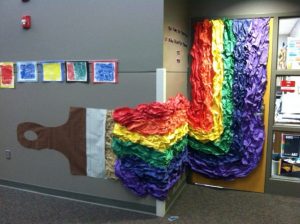CCSS.Math.Content.6.RP.A.3
Use ratio and rate reasoning to solve real-world and mathematical problems, e.g., by reasoning about tables of equivalent ratios, tape diagrams, double number line diagrams, or equations.
CCSS.Math.Practice.MP4 Model with mathematics.
CCSS.Math.Practice.MP5 Use appropriate tools strategically.
CCSS.Math.Practice.MP3 Construct viable arguments and critique the reasoning of others.
Lesson objective: I can create a model that shows how two values compare to one another.
This is a real-world activity to introduce proportions and ratios. This activity allows students to see that proportions are not just something you see on math worksheets, but in everyday life. This lesson relates to the fine arts, which helps culturally diverse students learn the mathematical concept better. Fine arts such as painting has been known to express complex cultural issues and their heritage has been translated into exchangeable value. The intuitive need for students to express themselves is precisely why the arts are an ideal vehicle to develop language, deliver content, and encourage academic exploration in school in culturally responsive ways. Learning, communicating, and questioning in alignment with the arts develops a dynamic classroom environment where students are excited and engaged in this process. Therefore, integrating arts into learning results in a more engaging classroom for students of all backgrounds.
This activity relates to all students as we are talking about physically painting our classroom once students have accurately problem solved how to paint our classroom the perfect purple. In order to create the perfect purple color, we must need the perfect mixture: two cups of blue paint and three cups of red paint. After measuring our classroom, we decided we need a total of 35 cups of our perfect purple paint to coat the walls. Students will be given the opportunity to work with their peers and with manipulatives to decide how much of each color would be needed to make a total of 35 cups of perfect purple paint. The manipulative provided will be interlocking colored math cubes that the students can build the proportion of the ratio for every three cups of red there needs to be two cups of blue. Once students have had an opportunity to work through the problem using just the interlocking colored math cubes, their peers, and teacher as support, then students will present their ideas to the whole class. As the teacher guides this whole class discussion, the students and teacher will come to the conclusion of the correct amount of blue and red paint needed to create the perfect purple to paint our classroom.
Student Handout: MATH 325 perfect purple paint
